Содержание
- 2. Emergency Diagnosis & Management About 10% of all injuries seen in the emergency room involve the
- 3. Many of them are subtle and difficult to define and require great diagnostic expertise. Early diagnosis
- 4. Emergency Diagnosis & Management Initial assessment should include control of hemorrhage and shock along with resuscitation
- 5. Emergency Diagnosis & Management The history should include a detailed description of the accident. In cases
- 6. Emergency Diagnosis & Management The abdomen and genitalia should be examined for evidence of contusions or
- 7. Fractures of the lower ribs are often associated with renal injuries, and pelvic fractures often accompany
- 8. Patients who do not have life-threatening injuries and whose blood pressure is stable can undergo more
- 9. Emergency Diagnosis & Management When genitourinary tract injury is suspected on the basis of the history
- 10. Assessment of Injury Assessment of the injury should be done in an orderly fashion so that
- 11. Catheterization Blood at the urethral meatus in men indicates urethral injury; catheterization should not be attempted
- 12. Catheterization If no blood is present at the meatus, a urethral catheter can be carefully passed
- 13. Catheterization If catheterization is traumatic despite the greatest care, the significance of hematuria cannot be determined,
- 14. Computed Tomography (CT) Abdominal CT with contrast media is the best imaging study to detect and
- 15. Computed Tomography (CT) It can define the size extent of the retroperitoneal hematoma
- 16. Computed Tomography (CT) Spiral CT scanning, now common, is very rapid, but it may not detect
- 17. Retrograde Cystography Filling of the bladder with contrast material is essential to establish whether bladder perforations
- 18. Retrograde Cystography A film should be obtained with the bladder filled and a second one after
- 19. Retrograde Cystography Cystography with CT is excellent for establishing bladder injury.
- 20. Urethrography A small (12F) catheter can be inserted into the urethral meatus and 3 mL of
- 21. Urethrography After retrograde injection of 20 mL of water-soluble contrast material, the urethra will be clearly
- 22. Arteriography Arteriography may help define renal parenchymal and renal vascular injuries.
- 23. Intravenous Urography Intravenous urography can be used to detect renal and ureteral injury.
- 24. Cystoscopy and Retrograde Urography Cystoscopy and retrograde urography may be useful to detect ureteral injury, but
- 25. Abdominal Sonography Abdominal sonography has not been shown to add substantial information during initial evaluation of
- 26. Injuries to the Kidney Renal injuries are the most common injuries of the urinary system.
- 27. Injuries to the Kidney Most injuries occur from automobile accidents or sporting mishaps, chiefly in men
- 28. Injuries to the Kidney Etiology Blunt trauma directly to the abdomen, flank, or back is the
- 29. Injuries to the Kidney Vehicle collisions at high speed may result in major renal trauma from
- 30. Injuries to the Kidney Associated abdominal visceral injuries are present in 80% of renal penetrating wounds.
- 31. Pathology & Classification Early Pathologic Findings Lacerations from blunt trauma usually occur in the transverse plane
- 32. Pathology & Classification Early Pathologic Findings In injuries from rapid deceleration, the kidney moves upward or
- 33. Pathology & Classification Early Pathologic Findings Acute thrombosis of the renal artery may be caused by
- 34. Pathology & Classification Hydronephrosis Follow-up excretory urography is indicated in all cases of major renal trauma.
- 35. Pathology & Classification Arteriovenous Fistula Arteriovenous fistulas may occur after penetrating injuries but are not common
- 36. Pathology & Classification Renal Vascular Hypertension The blood flow in tissue rendered nonviable by injury is
- 37. Clinical Findings & Indications for Studies Microscopic or gross hematuria following trauma to the abdomen indicates
- 38. Clinical Findings & Indications for Studies Some cases of renal vascular injury are not associated with
- 39. Clinical Findings & Indications for Studies The degree of renal injury does not correspond to the
- 40. Clinical Findings & Indications for Studies Miller and McAninch (1995) made the following recommendations based on
- 41. Clinical Findings & Indications for Studies However, should physical examination or associated injuries prompt reasonable suspicion
- 42. Clinical Findings & Indications for Studies Symptoms There is usually visible evidence of abdominal trauma. Pain
- 43. Clinical Findings & Indications for Studies Catheterization usually reveals hematuria.
- 44. Clinical Findings & Indications for Studies Signs Initially, shock or signs of a large loss of
- 45. Clinical Findings & Indications for Studies Signs Diffuse abdominal tenderness may be found on palpation; an
- 46. Clinical Findings & Indications for Studies Signs The abdomen may be distended and bowel sounds absent.
- 47. Clinical Findings & Indications for Studies Laboratory Findings Microscopic or gross hematuria is usually present.
- 48. Clinical Findings & Indications for Studies Staging and X-Ray Findings Staging of renal injuries allows a
- 49. Clinical Findings & Indications for Studies Staging and X-Ray Findings For example, blunt trauma to the
- 50. Clinical Findings & Indications for Studies Staging and X-Ray Findings Ultrasonography and retrograde urography are of
- 51. Clinical Findings & Indications for Studies Staging and X-Ray Findings Staging begins with an abdominal CT
- 52. Clinical Findings & Indications for Studies Staging and X-Ray Findings This noninvasive technique clearly defines parenchymal
- 53. Clinical Findings & Indications for Studies Staging and X-Ray Findings Arteriography defines major arterial and parenchymal
- 54. Clinical Findings & Indications for Studies Staging and X-Ray Findings The major causes of nonvisualization on
- 55. Clinical Findings & Indications for Studies Staging and X-Ray Findings Radionuclide renal scans have been used
- 56. Clinical Findings & Indications for Studies Differential Diagnosis Trauma to the abdomen and flank areas is
- 57. Clinical Findings & Indications for Studies Complications Early Complications Hemorrhage is perhaps the most important immediate
- 58. Clinical Findings & Indications for Studies Complications The size and expansion of palpable masses must be
- 59. Clinical Findings & Indications for Studies Complications Urinary extravasation from renal fracture may show as an
- 60. Clinical Findings & Indications for Studies Complications A resolving retroperitoneal hematoma may cause slight fever (38.3
- 61. Clinical Findings & Indications for Studies Complications Late Complications Hypertension, hydronephrosis, arteriovenous fistula, calculus formation, and
- 62. Clinical Findings & Indications for Studies Complications Heavy late bleeding may occur 4 weeks after injury.
- 63. Clinical Findings & Indications for Studies Treatment: Emergency Measures The objectives of early management are prompt
- 64. Clinical Findings & Indications for Studies Treatment: Surgical Measures Blunt Injuries Bleeding stops spontaneously with bed
- 65. Clinical Findings & Indications for Studies Treatment: Surgical Measures Cases in which operation is indicated include
- 66. Clinical Findings & Indications for Studies Treatment: Surgical Measures Penetrating Injuries Penetrating injuries should be surgically
- 67. Clinical Findings & Indications for Studies Treatment: Surgical Measures In 80% of cases of penetrating injury,
- 68. Clinical Findings & Indications for Studies Treatment: Surgical Measures Treatment of Complications Hydronephrosis may require surgical
- 69. Clinical Findings & Indications for Studies Treatment: Surgical Measures Prognosis With careful follow-up, most renal injuries
- 70. Clinical Findings & Indications for Studies Treatment: Surgical Measures Injuries to the Ureter Ureteral injury is
- 71. Clinical Findings & Indications for Studies Treatment: Surgical Measures Etiology Large pelvic masses (benign or malignant)
- 72. Clinical Findings & Indications for Studies Treatment: Surgical Measures Extensive carcinoma of the colon may invade
- 73. Clinical Findings & Indications for Studies Treatment: Surgical Measures Devascularization may occur with extensive pelvic lymph
- 74. Clinical Findings & Indications for Studies Treatment: Surgical Measures Endoscopic manipulation of a ureteral calculus with
- 75. Clinical Findings & Indications for Studies Treatment: Surgical Measures Pathogenesis & Pathology The ureter may be
- 76. Clinical Findings & Indications for Studies Treatment: Surgical Measures Intraperitoneal extravasation of urine can also occur,
- 77. Clinical Findings Symptoms If the ureter has been completely or partially ligated during operation, the postoperative
- 78. Clinical Findings Symptoms Ureteral injuries from external violence should be suspected in patients who have sustained
- 79. Clinical Findings Symptoms Signs The acute hydronephrosis of a totally ligated ureter results in severe flank
- 80. Clinical Findings Symptoms Watery discharge from the wound or vagina may be identified as urine by
- 81. Laboratory Findings Ureteral injury from external violence is manifested by microscopic hematuria in 90% of cases.
- 82. Imaging Findings Diagnosis is by excretory urography.
- 83. Imaging Findings Partial transection of the ureter results in more rapid excretion, but persistent hydronephrosis is
- 84. Imaging Findings In acute injury from external violence, the excretory urogram usually appears normal, with very
- 85. Ultrasonography Ultrasonography outlines hydroureter or urinary extravasation as it develops into a urinoma and is perhaps
- 86. Radionuclide Scanning Radionuclide scanning demonstrates delayed excretion on the injured side, with evidence of increasing counts
- 87. Differential Diagnosis Postoperative bowel obstruction and peritonitis may cause symptoms similar to those of acute ureteral
- 88. Differential Diagnosis Deep wound infection must be considered postoperatively in patients with fever, ileus, and localized
- 89. Differential Diagnosis Acute pyelonephritis in the early postoperative period may also result in findings similar to
- 90. Complications Ureteral injury may be complicated by stricture formation with resulting hydronephrosis in the area of
- 91. Treatment Prompt treatment of ureteral injuries is required. The best opportunity for successful repair is in
- 92. Treatment Proximal urinary drainage by percutaneous nephrostomy or formal nephrostomy should be considered if the injury
- 93. Treatment The goals of ureteral repair are to achieve complete debridement, a tension-free spatulated anastomosis, watertight
- 94. Lower Ureteral Injuries Injuries to the lower third of the ureter allow several options in management.
- 95. Lower Ureteral Injuries An antireflux procedure should be done when possible.
- 96. Lower Ureteral Injuries Transureteroureterostomy may be used in lower-third injuries if extensive urinoma and pelvic infection
- 97. Midureteral Injuries Midureteral injuries usually result from external violence and are best repaired by primary ureteroureterostomy
- 98. Upper Ureteral Injuries Injuries to the upper third of the ureter are best managed by primary
- 99. Stenting Most anastomoses after repair of ureteral injury should be stented.
- 100. Stenting After 3-4 weeks of healing, stents can be endoscopically removed from the bladder.
- 101. Prognosis The prognosis for ureteral injury is excellent if the diagnosis is made early and prompt
- 102. Injuries to the Bladder Bladder injuries occur most often from external force and are often associated
- 103. Injuries to the Bladder Iatrogenic injury may result from gynecologic and other extensive pelvic procedures as
- 104. Injuries to the Bladder Pathogenesis & Pathology The bony pelvis protects the urinary bladder very well.
- 105. Injuries to the Bladder Pathogenesis & Pathology When the bladder is filled to near capacity, a
- 106. Injuries to the Bladder Pathogenesis & Pathology If the diagnosis is not established immediately and if
- 107. Injuries to the Bladder Clinical Findings Pelvic fracture accompanies bladder rupture in 90% of cases.
- 108. Injuries to the Bladder Symptoms There is usually a history of lower abdominal trauma.
- 109. Injuries to the Bladder Signs Heavy bleeding associated with pelvic fracture may result in hemorrhagic shock,
- 110. Injuries to the Bladder Signs An acute abdomen may occur with intraperitoneal bladder rupture.
- 111. Injuries to the Bladder Laboratory Findings Catheterization usually is required in patients with pelvic trauma but
- 112. Injuries to the Bladder Laboratory Findings When catheterization is done, gross or, less commonly, microscopic hematuria
- 113. Injuries to the Bladder X-Ray Findings A plain abdominal film generally demonstrates pelvic fractures.
- 114. Injuries to the Bladder X-Ray Findings Bladder disruption is shown on cystography.
- 115. Injuries to the Bladder X-Ray Findings The drainage film is extremely important, because it demonstrates areas
- 116. Injuries to the Bladder X-Ray Findings CT cystography is an excellent method for detecting bladder rupture;
- 117. Injuries to the Bladder X-Ray Findings Incomplete distention with consequent missed diagnosis of bladder rupture often
- 118. Injuries to the Bladder Complications A pelvic abscess may develop from extraperitoneal bladder rupture; if the
- 119. Injuries to the Bladder Complications Partial incontinence may result from bladder injury when the laceration extends
- 120. Injuries to the Bladder Treatment Emergency Measures Shock and hemorrhage should be treated.
- 121. Injuries to the Bladder Treatment Surgical Measures A lower midline abdominal incision should be made.
- 122. Injuries to the Bladder Treatment The bladder should be opened in the midline and carefully inspected.
- 123. Injuries to the Bladder Treatment Extraperitoneal Bladder Rupture Extraperitoneal bladder rupture can be successfully managed with
- 124. Injuries to the Bladder Treatment As the bladder is opened in the midline, it should be
- 125. Injuries to the Bladder Treatment Extraperitoneal bladder lacerations occasionally extend into the bladder neck and should
- 126. Injuries to the Bladder Treatment Intraperitoneal Rupture Intraperitoneal bladder ruptures should be repaired via a transperitoneal
- 127. Injuries to the Bladder Treatment The bladder is then closed in separate layers by absorbable suture.
- 128. Injuries to the Bladder Treatment Pelvic Fracture Stable fracture of the pubic rami is usually present.
- 129. Injuries to the Bladder Treatment Pelvic Hematoma There may be heavy uncontrolled bleeding from rupture of
- 130. Injuries to the Bladder Treatment If bleeding persists, it may be necessary to leave the tapes
- 131. Injuries to the Bladder Treatment Prognosis With appropriate treatment, the prognosis is excellent.
- 132. Injuries to the Bladder Treatment Patients with lacerations extending into the bladder neck area may be
- 133. Injuries to the Urethra Urethral injuries are uncommon and occur most often in men, usually associated
- 134. Injuries to the Urethra Various parts of the urethra may be lacerated, transected, or contused.
- 135. Injuries to the Posterior Urethra Etiology The membranous urethra passes through the pelvic floor and voluntary
- 136. Injuries to the Posterior Urethra The urethra can be transected by the same mechanism at the
- 137. Injuries to the Posterior Urethra Clinical Findings Symptoms Patients usually complain of lower abdominal pain and
- 138. Injuries to the Posterior Urethra Clinical Findings Signs Blood at the urethral meatus is the single
- 139. Injuries to the Posterior Urethra Clinical Findings The presence of blood at the external urethral meatus
- 140. Injuries to the Posterior Urethra Clinical Findings Suprapubic tenderness and the presence of pelvic fracture are
- 141. Injuries to the Posterior Urethra Clinical Findings Rectal examination may reveal a large pelvic hematoma with
- 142. Injuries to the Posterior Urethra Clinical Findings Superior displacement of the prostate does not occur if
- 143. Injuries to the Posterior Urethra X-Ray Findings Fractures of the bony pelvis are usually present. A
- 144. Injuries to the Posterior Urethra X-Ray Findings Ordinarily, there is free extravasation of contrast material into
- 145. Injuries to the Posterior Urethra Instrumental Examination The only instrumentation involved should be for urethrography.
- 146. Injuries to the Posterior Urethra Differential Diagnosis Bladder rupture may be associated with posterior urethral injuries
- 147. Injuries to the Posterior Urethra Complications Stricture, impotence, and incontinence as complications of prostatomembranous disruption are
- 148. Injuries to the Posterior Urethra Complications Stricture following primary repair and anastomosis occurs in about 50%
- 149. Injuries to the Posterior Urethra Complications The incidence of impotence after primary repair is 30-80% (mean,
- 150. Injuries to the Posterior Urethra Treatment Emergency Measures Shock and hemorrhage should be treated.
- 151. Injuries to the Posterior Urethra Treatment Surgical Measures Urethral catheterization should be avoided.
- 152. Injuries to the Posterior Urethra Treatment Immediate Management Initial management should consist of suprapubic cystostomy to
- 153. Injuries to the Posterior Urethra Treatment The bladder often is distended by a large volume of
- 154. Injuries to the Posterior Urethra Treatment The bladder should be opened in the midline and carefully
- 155. Injuries to the Posterior Urethra Treatment This approach involves no urethral instrumentation or manipulation.
- 156. Injuries to the Posterior Urethra Treatment Incomplete laceration of the posterior urethra heals spontaneously, and the
- 157. Injuries to the Posterior Urethra Treatment Delayed Urethral Reconstruction Reconstruction of the urethra after prostatic disruption
- 158. Injuries to the Posterior Urethra Treatment This stricture usually is 1 -2 cm long and situated
- 159. Injuries to the Posterior Urethra Treatment A 16F silicone urethral catheter should be left in place
- 160. Injuries to the Posterior Urethra Treatment Immediate Urethral Realignment Some surgeons prefer to realign the urethra
- 161. Injuries to the Posterior Urethra Treatment General Measures After delayed reconstruction by a perineal approach, patients
- 162. Injuries to the Posterior Urethra Treatment Treatment of Complications Approximately 1 month after the delayed reconstruction,
- 163. Injuries to the Posterior Urethra Treatment If the cystogram shows a patent area of reconstruction free
- 164. Injuries to the Posterior Urethra Treatment Stricture, if present (
- 165. Injuries to the Posterior Urethra Treatment The patient may be impotent for several months after delayed
- 166. Injuries to the Posterior Urethra Treatment Incontinence after posterior urethral rupture and delayed repair is rare
- 167. Injuries to the Posterior Urethra Treatment Prognosis If complications can be avoided, the prognosis is excellent.
- 168. Injuries to the Anterior Urethra Etiology The anterior urethra is the portion distal to the urogenital
- 169. Injuries to the Anterior Urethra Pathogenesis & Pathology Contusion Contusion of the urethra is a sign
- 170. Injuries to the Anterior Urethra Pathogenesis & Pathology Laceration A severe straddle injury may result in
- 171. Injuries to the Anterior Urethra Clinical Findings Symptoms There is usually a history of a fall,
- 172. Injuries to the Anterior Urethra Clinical Findings If voiding has occurred and extravasation is noted, sudden
- 173. Injuries to the Anterior Urethra Clinical Findings Signs The perineum is very tender, and a mass
- 174. Injuries to the Anterior Urethra Clinical Findings No attempt should be made to pass a urethral
- 175. Injuries to the Anterior Urethra Clinical Findings When presentation of such injuries is delayed, there is
- 176. Injuries to the Anterior Urethra Laboratory Findings Blood loss is not usually excessive, particularly if secondary
- 177. Injuries to the Anterior Urethra X-Ray Findings A contused urethra shows no evidence of extravasation.
- 178. Injuries to the Anterior Urethra Complications Heavy bleeding from the corpus spongiosum injury may occur in
- 179. Injuries to the Anterior Urethra Complications The complications of urinary extravasation are chiefly sepsis and infection.
- 180. Injuries to the Anterior Urethra Complications Stricture at the site of injury is a common complication,
- 181. Injuries to the Anterior Urethra Treatment General Measures Major blood loss usually does not occur from
- 182. Injuries to the Anterior Urethra Treatment Specific Measures: Urethral Contusion The patient with urethral contusion shows
- 183. Injuries to the Anterior Urethra Treatment Urethral Lacerations Instrumentation of the urethra following urethrography should be
- 184. Injuries to the Anterior Urethra Treatment If only minor extravasation is noted on the urethrogram, a
- 185. Injuries to the Anterior Urethra Treatment Most of these strictures are not severe and do not
- 186. Injuries to the Anterior Urethra Treatment Urethral Laceration with Extensive Urinary Extravasation After major laceration, urinary
- 187. Injuries to the Anterior Urethra Treatment Immediate Repair Immediate repair of urethral lacerations can be performed,
- 188. Injuries to the Anterior Urethra Treatment Treatment of Complications Strictures at the site of injury may
- 189. Injuries to the Anterior Urethra Treatment Prognosis Urethral stricture is a major complication but in most
- 190. Injuries to the Penis Disruption of the tunica albuginea of the penis (penile fracture) can occur
- 191. Injuries to the Penis Gangrene and urethral injury may be caused by obstructing rings placed around
- 192. Injuries to the Penis Injuries to the penis should suggest possible urethral damage, which should be
- 193. Injuries to the Scrotum Superficial lacerations of the scrotum may be debrided and closed primarily. Blunt
- 194. Injuries to the Scrotum Total avulsion of the scrotal skin may be caused by machinery accidents
- 195. Injuries to the Scrotum Later reconstruction of the scrotum can be done with a skin graft
- 197. Скачать презентацию













































































































































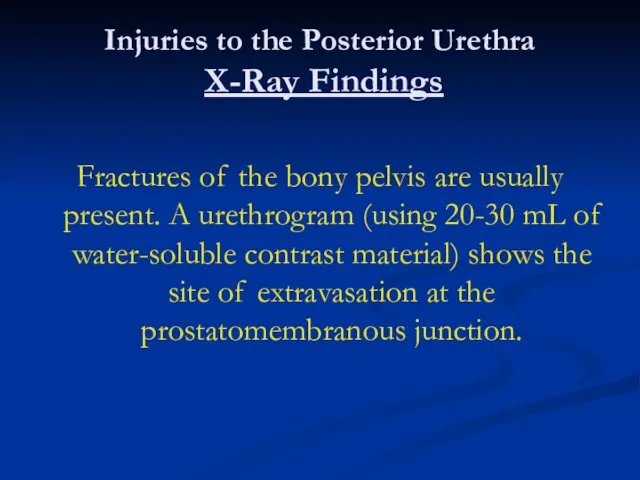
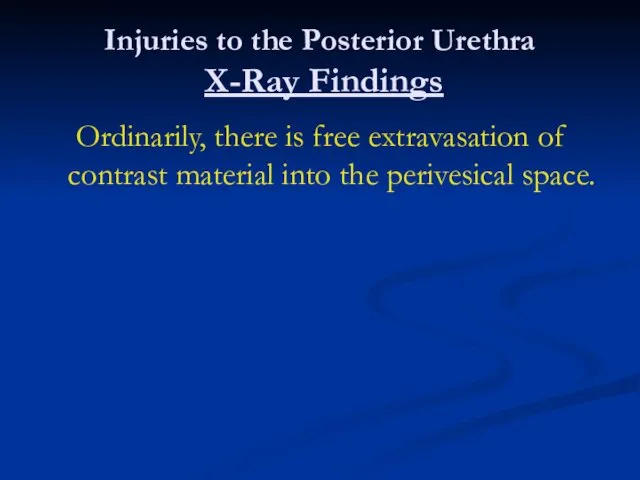

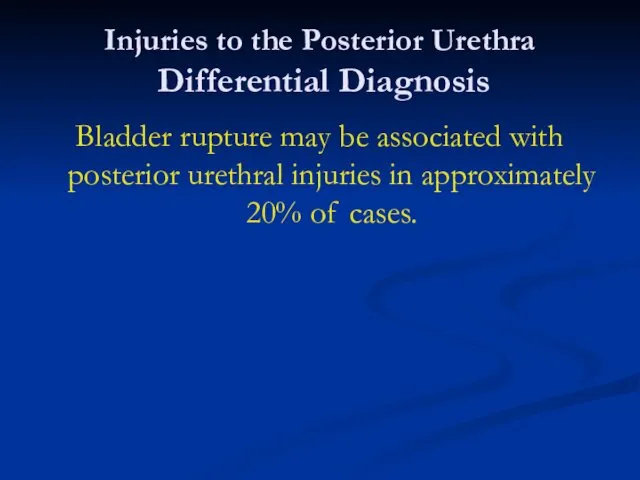
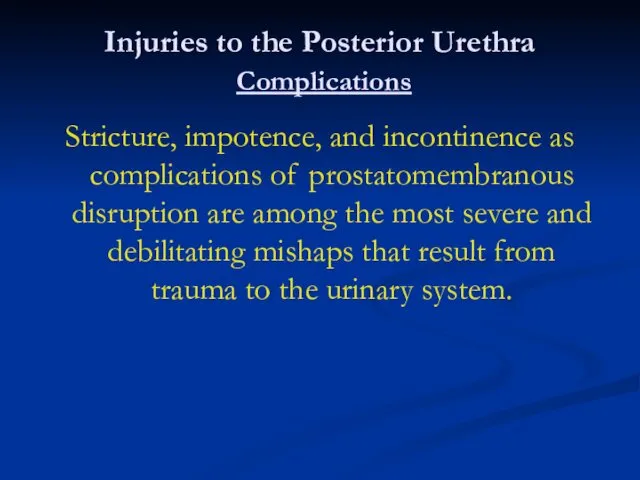
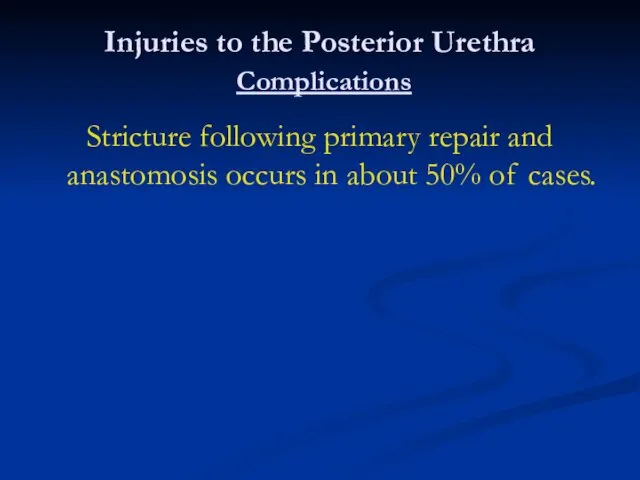
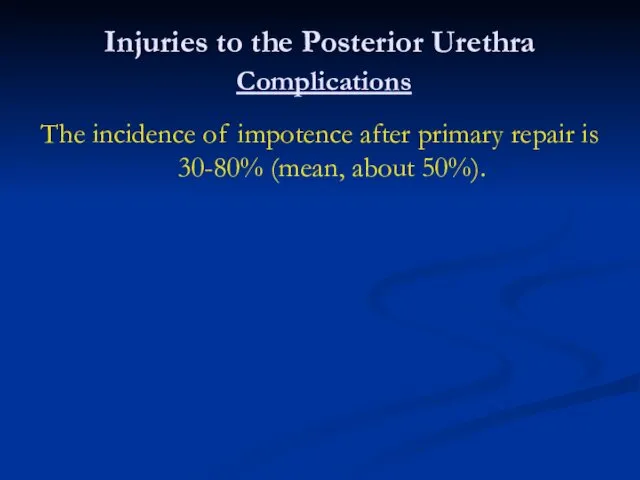
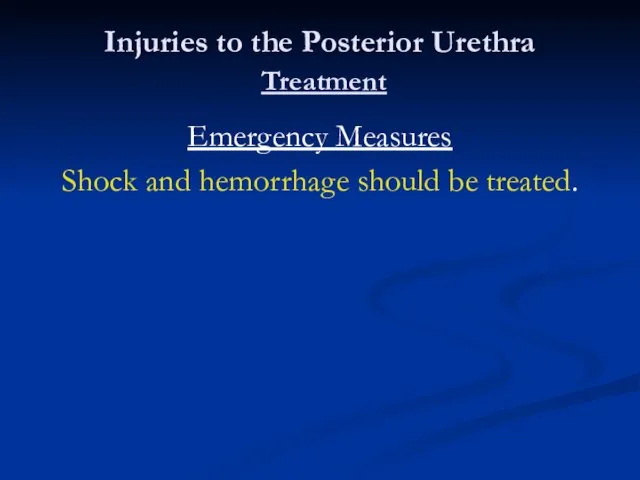
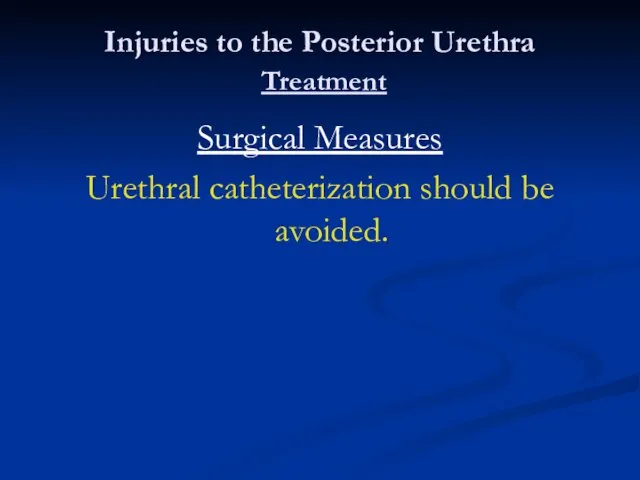
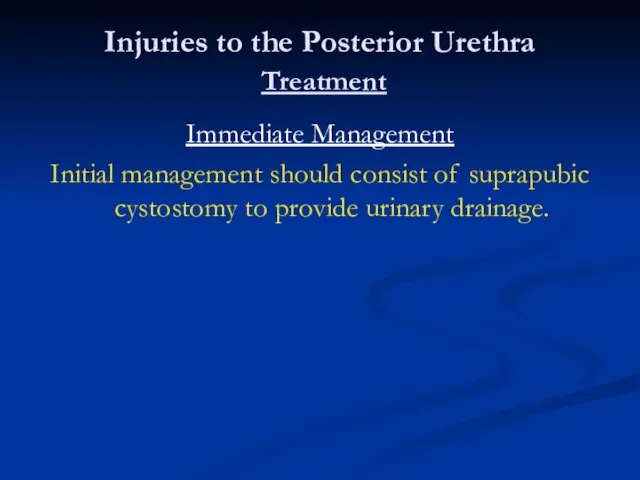
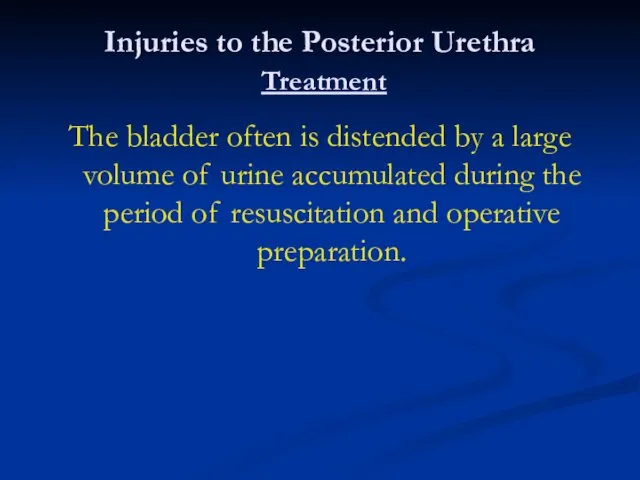
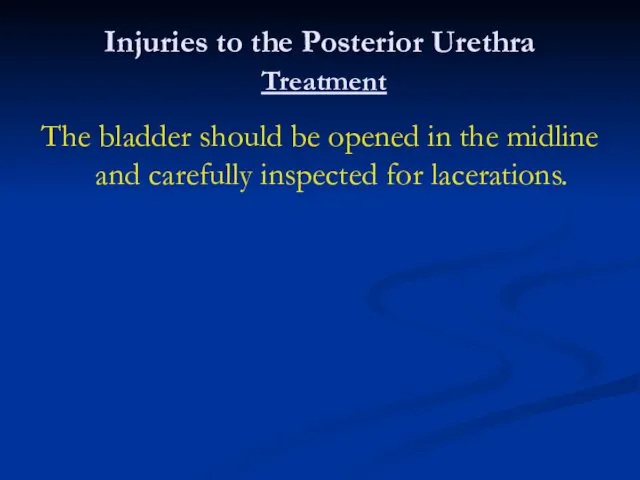
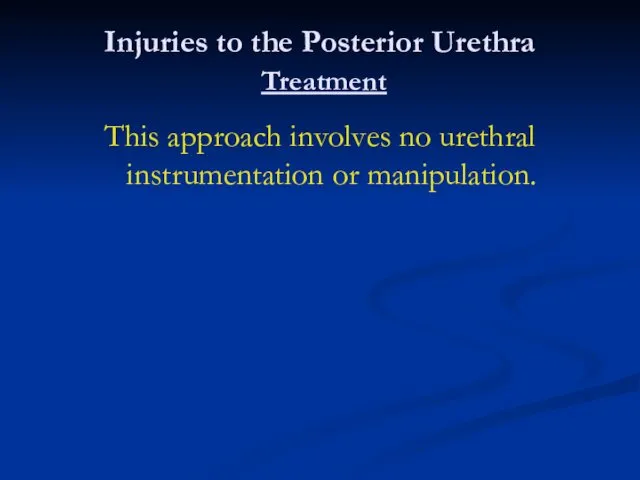
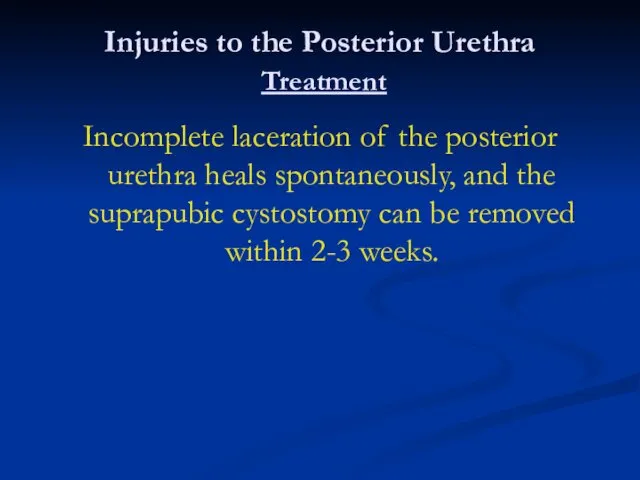
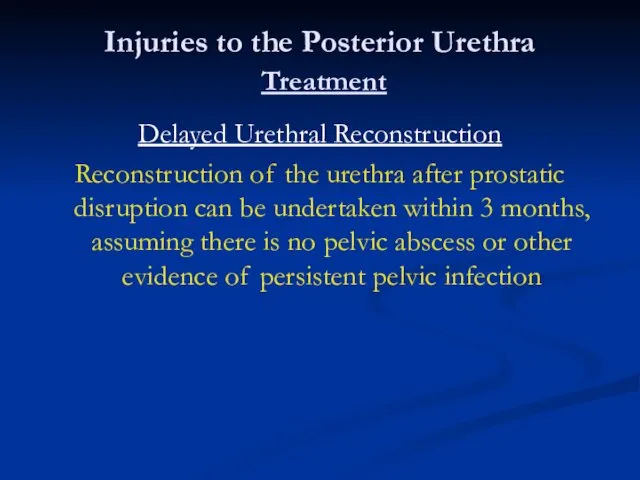
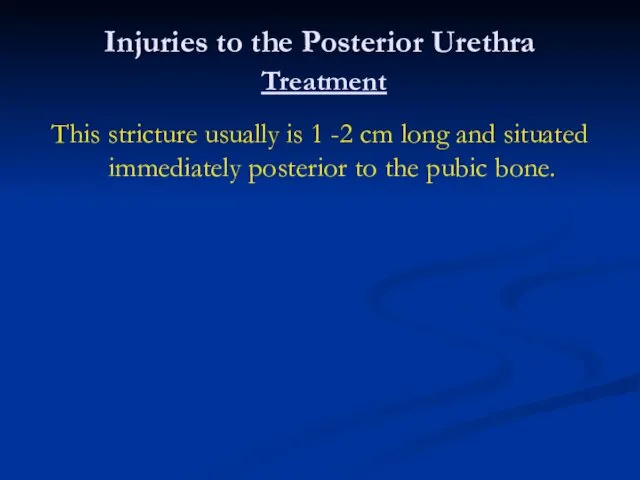
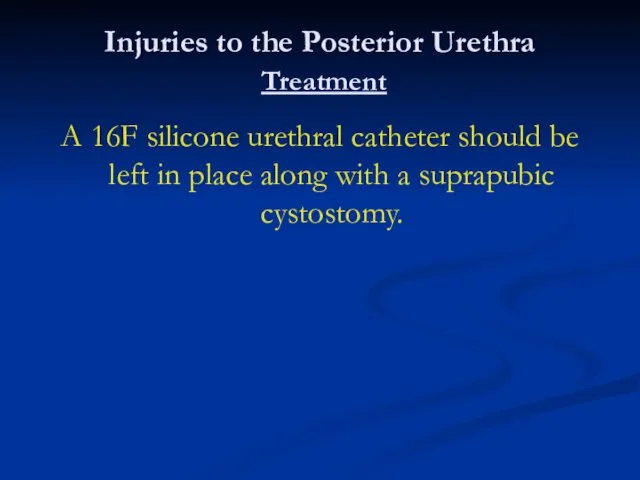

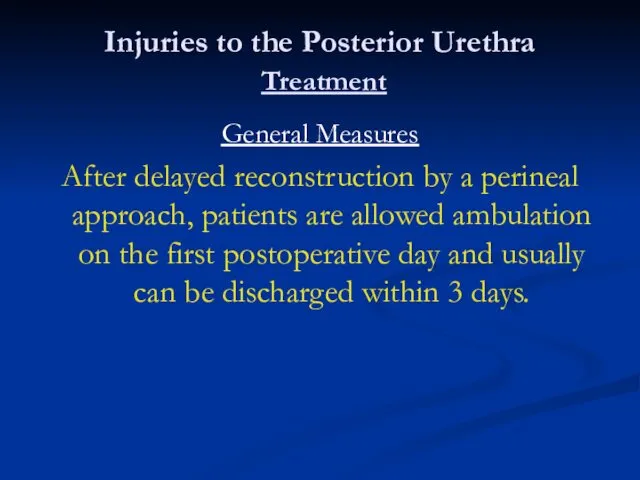
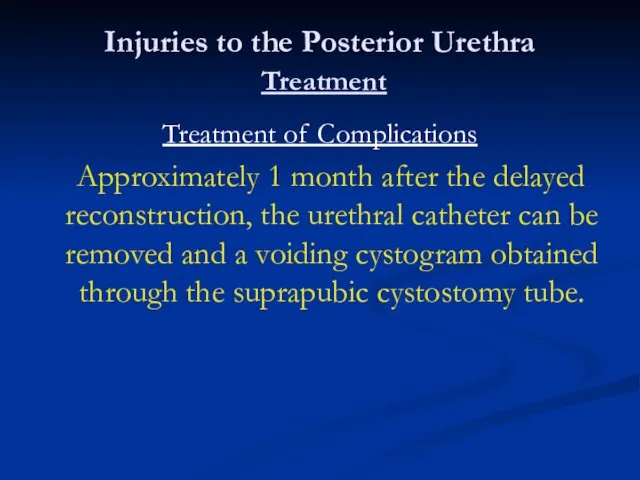
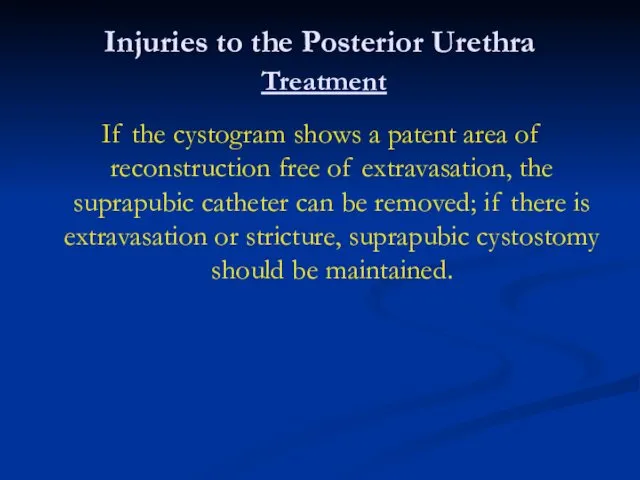

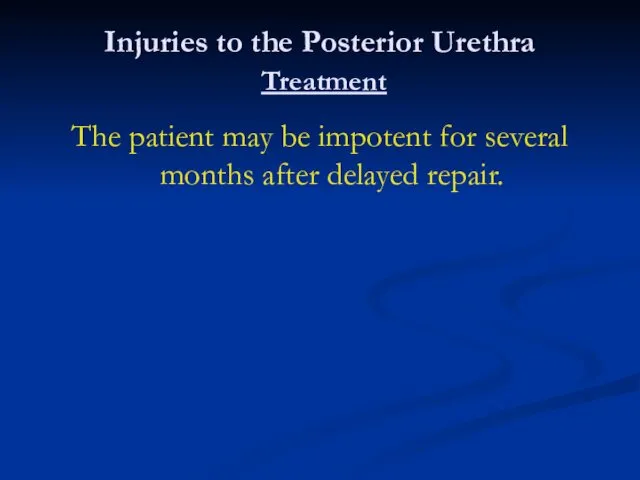
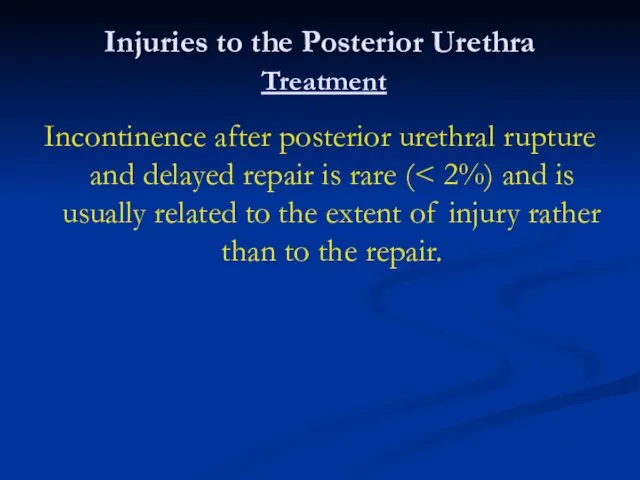
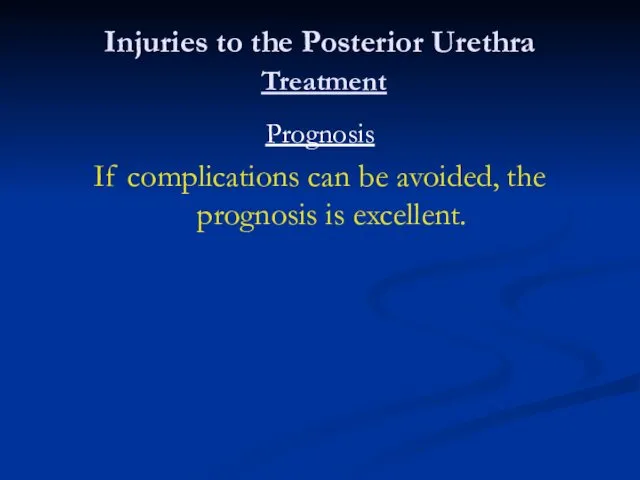
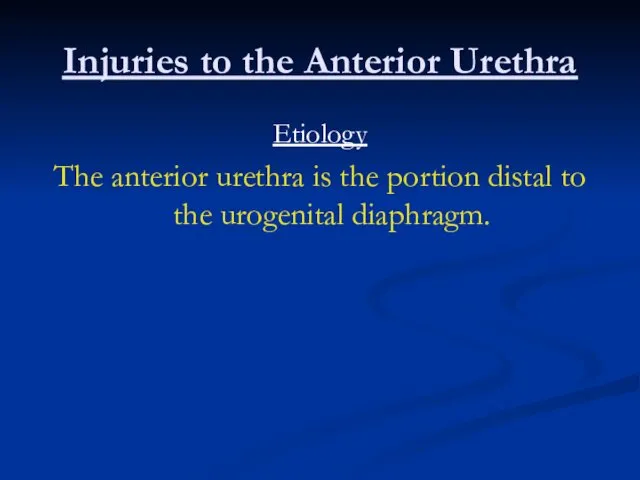
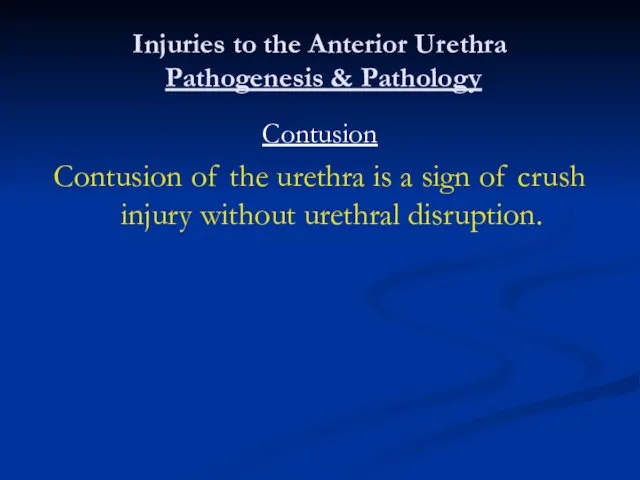
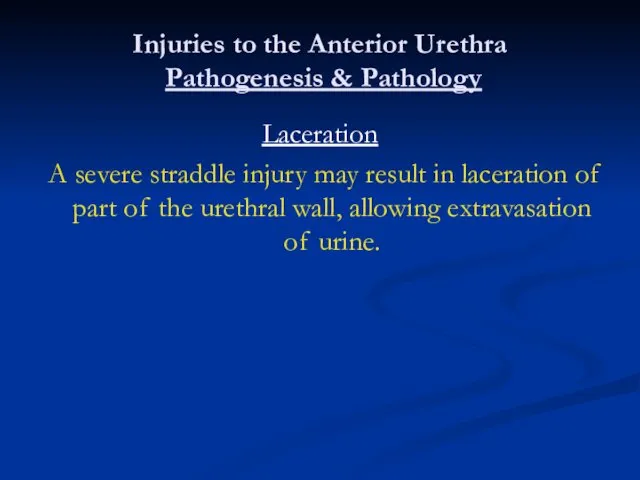
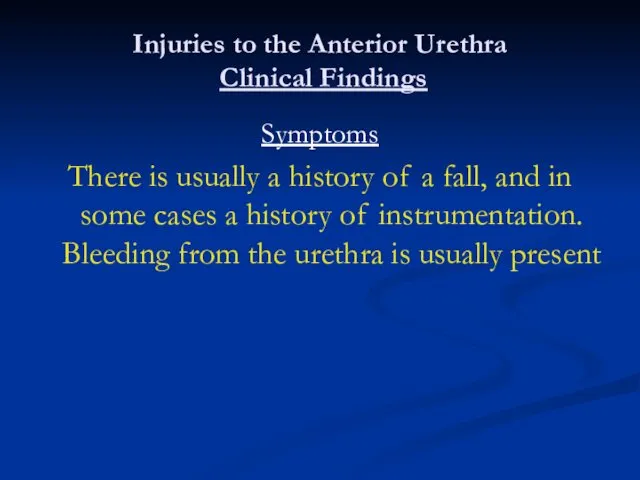
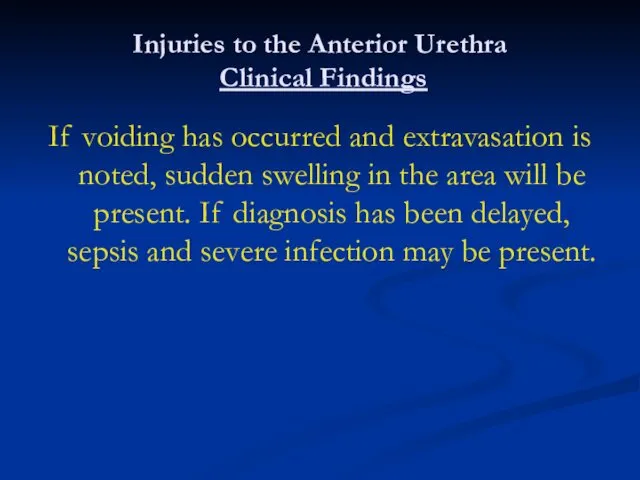
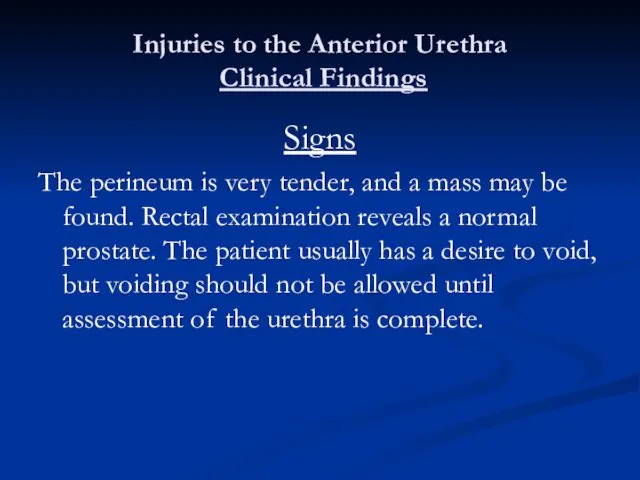
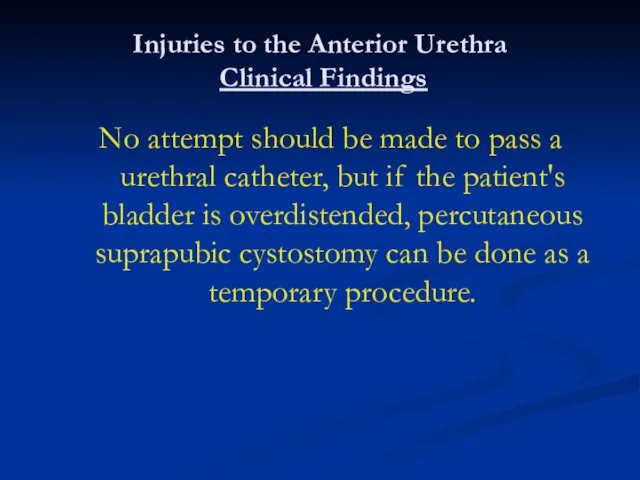
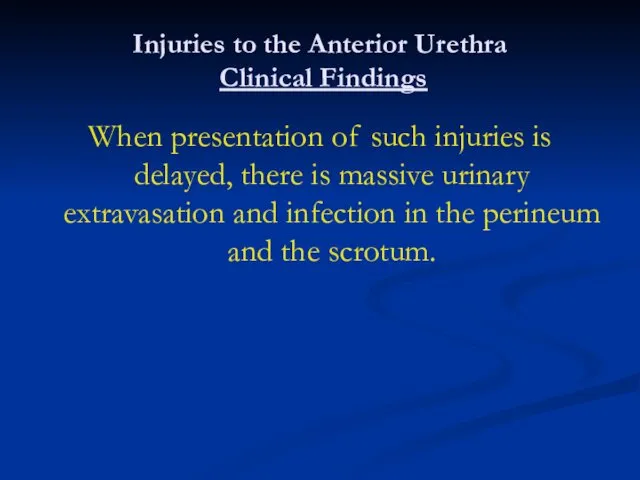
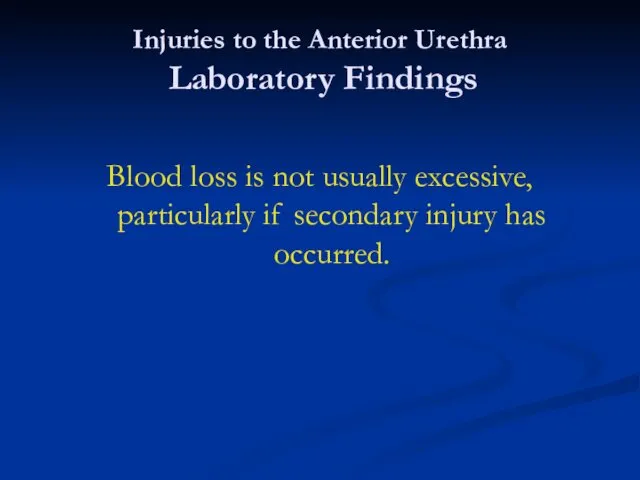
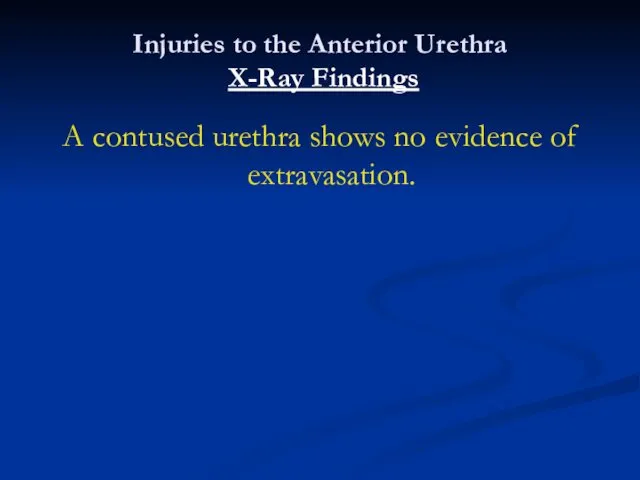
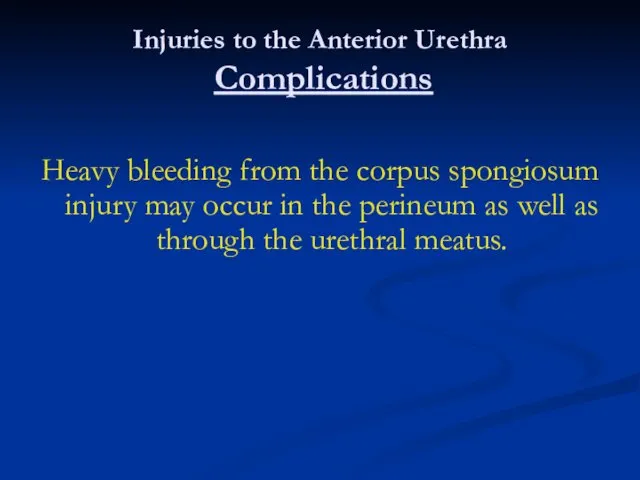
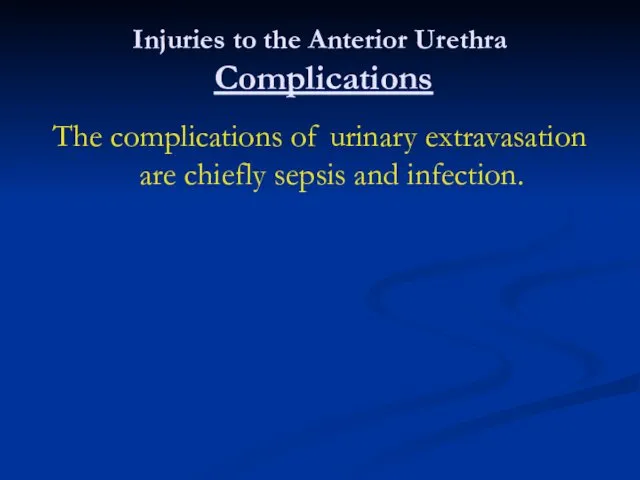
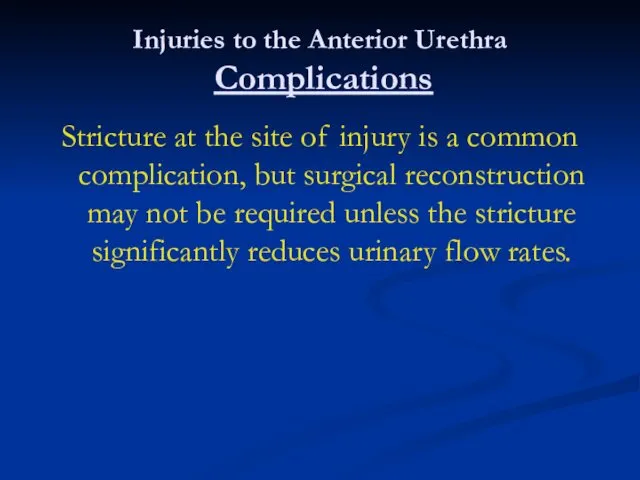
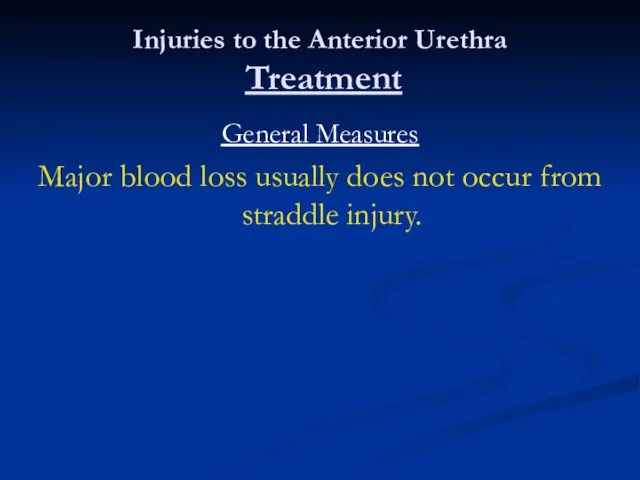
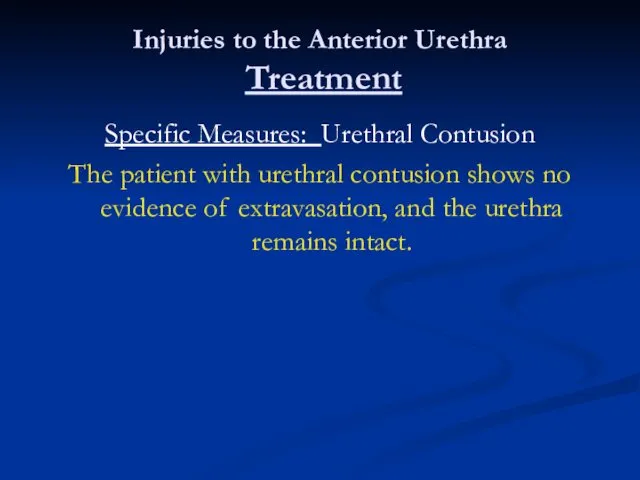
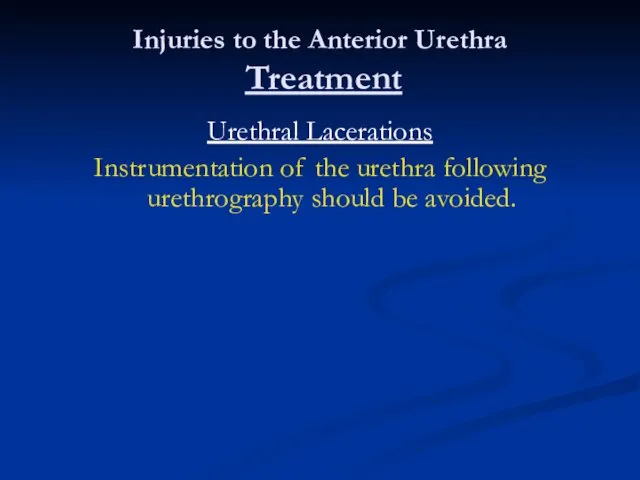
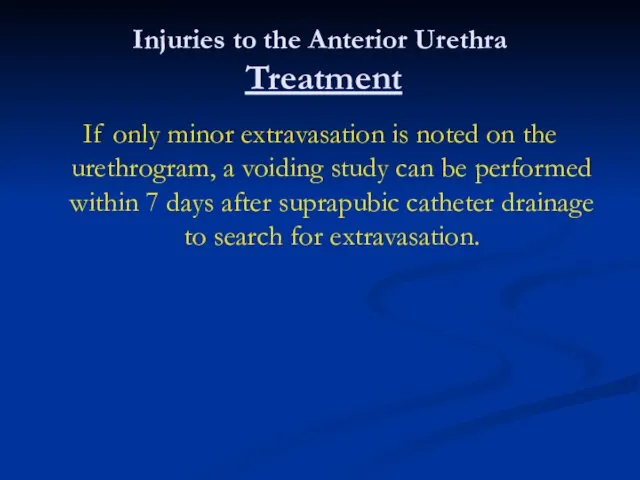
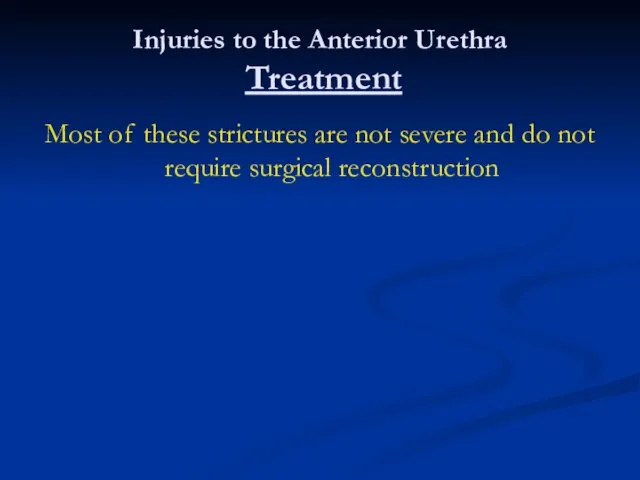
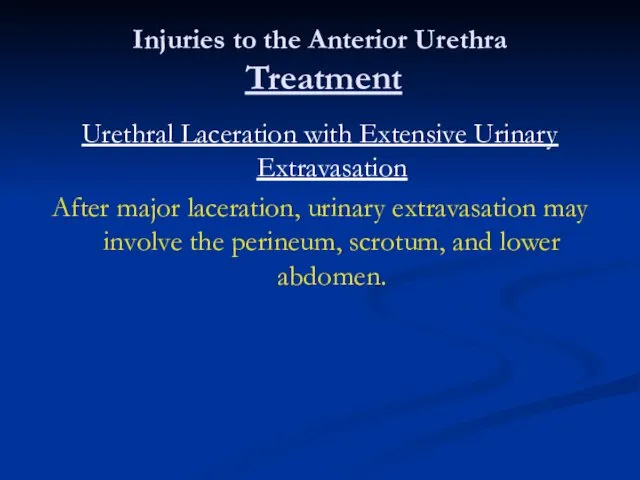
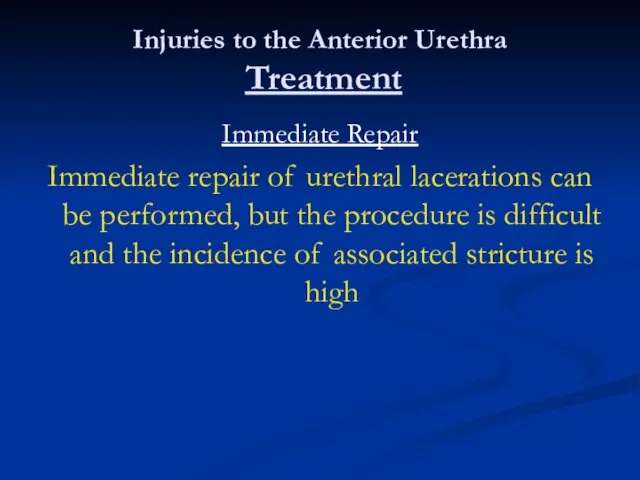
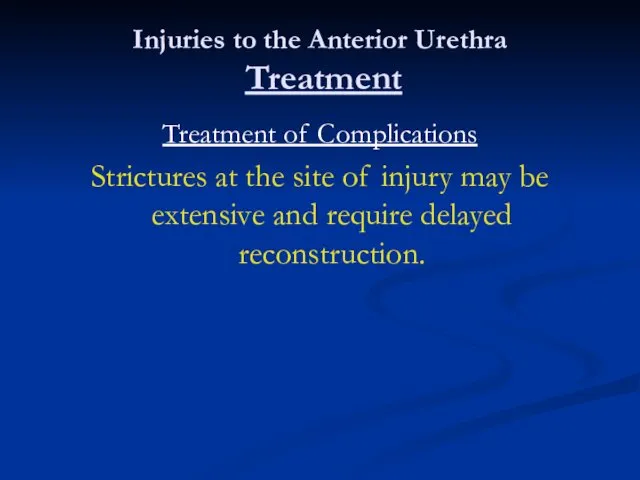

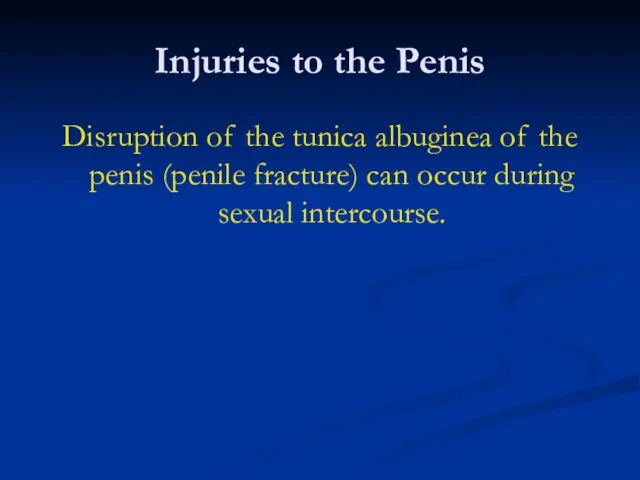
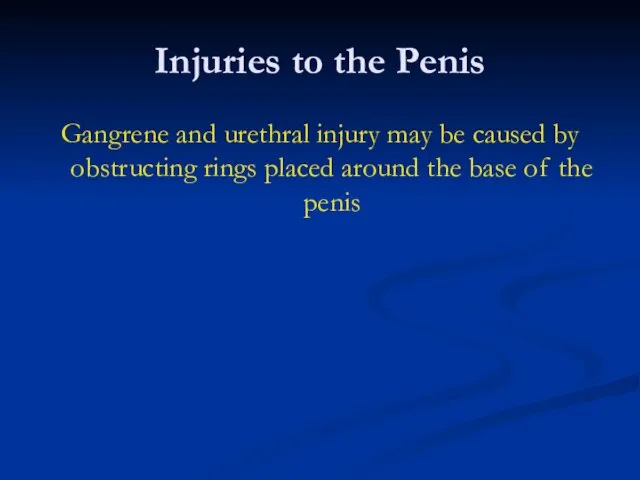
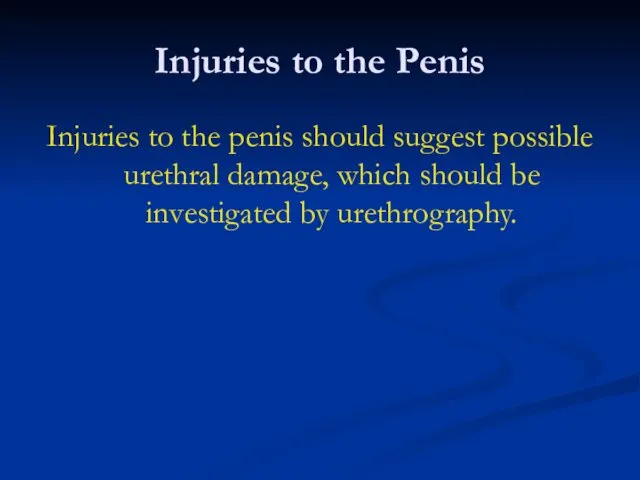
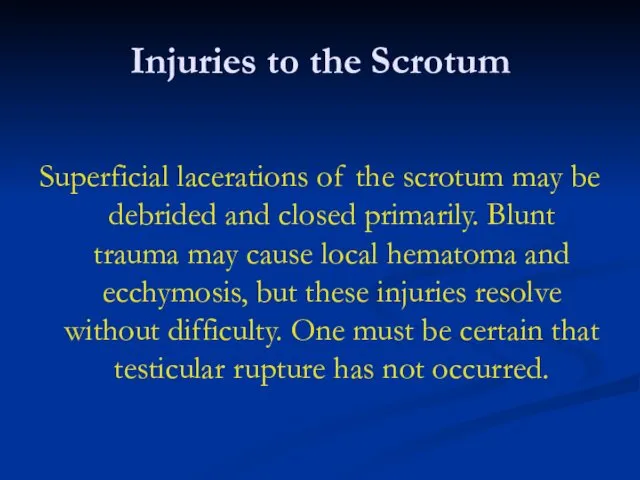
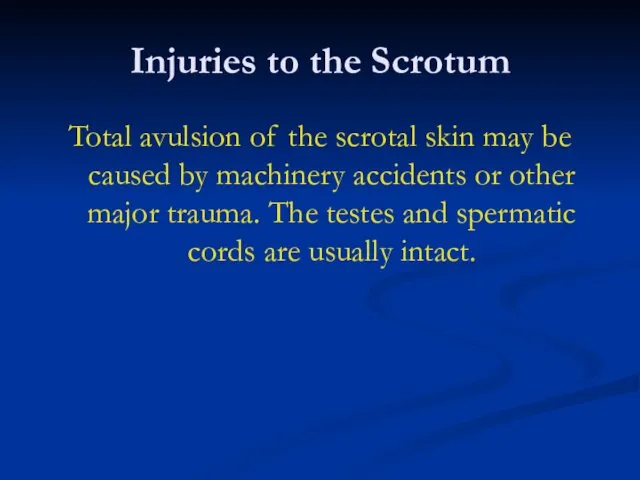
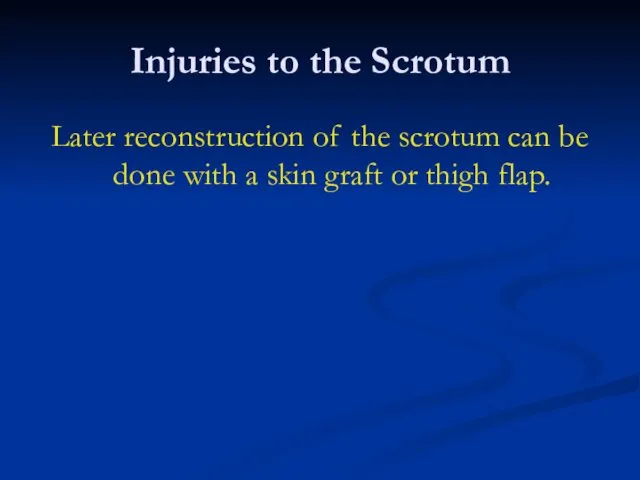
 Протезирование на имплантатах
Протезирование на имплантатах Здоровое питание - активное долголетие
Здоровое питание - активное долголетие Общая характеристика группы инфекционных болезней с воздушнокапельным механизмом передачи. Грипп
Общая характеристика группы инфекционных болезней с воздушнокапельным механизмом передачи. Грипп Болезни, передаваемые половым путем
Болезни, передаваемые половым путем Шығармашылық модельдеу және рестоврациялау
Шығармашылық модельдеу және рестоврациялау Ішкі сәулеленуден медициналық қорғану
Ішкі сәулеленуден медициналық қорғану Вакцины и сыворотки
Вакцины и сыворотки Вирусты гепатит В
Вирусты гепатит В Гормональні зміни впродовж статевого циклу у коров
Гормональні зміни впродовж статевого циклу у коров Естественное вскармливание. Преимущества. Питание, режим и гигиена кормящей матери
Естественное вскармливание. Преимущества. Питание, режим и гигиена кормящей матери Лабораторная диагностика нарушений гемостаза. Коагуляционный гемостаз
Лабораторная диагностика нарушений гемостаза. Коагуляционный гемостаз Современные алгоритмы лечения СД и его осложнений
Современные алгоритмы лечения СД и его осложнений Лекарственная терапия диссеминированного колоректального рака
Лекарственная терапия диссеминированного колоректального рака Фармакоэпидемиология және фармакоэканомика: анықтамасы, даму кезеңдері, негізгі қағидалары. 2 лекция
Фармакоэпидемиология және фармакоэканомика: анықтамасы, даму кезеңдері, негізгі қағидалары. 2 лекция Техникалық электр токтың әсерінен болған өлімнің сот медициналық сараптамасы
Техникалық электр токтың әсерінен болған өлімнің сот медициналық сараптамасы Теоретичні основи фізичної рекреації
Теоретичні основи фізичної рекреації ОКИ. Клиника, диагностика, лечение
ОКИ. Клиника, диагностика, лечение Нарушения периферического кровообращения
Нарушения периферического кровообращения Кесарево сечение в современном акушерстве
Кесарево сечение в современном акушерстве Гигиенические принципы здорового образа жизни
Гигиенические принципы здорового образа жизни Лечебная гимнастика и массаж при вибрационной болезни
Лечебная гимнастика и массаж при вибрационной болезни Нефролгия и урология
Нефролгия и урология Кишечные инфекции. Эшерихиозы
Кишечные инфекции. Эшерихиозы Алкогольная болезнь печени
Алкогольная болезнь печени Инсомния: проблема надуманная или актуальная
Инсомния: проблема надуманная или актуальная Поняття про онкогенні фактори та онкологічні захворювання
Поняття про онкогенні фактори та онкологічні захворювання Самай – төменгі жақсүйек буындарының аурулары мен зақымданулары. Жіктелуі. Ортопедиялық емі
Самай – төменгі жақсүйек буындарының аурулары мен зақымданулары. Жіктелуі. Ортопедиялық емі Техника и методика инъекций
Техника и методика инъекций